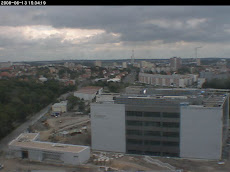We went to the Colosseum on Wednesday afternoon. We were a little concerned about getting in since it closes near sunset and by the time we got there - 3:00 or so - there wasn't much time left.
As we neared the ticket line we were approached by an American college-age kid asking if we were interested in a tour. We found out later that there are dozens of these people who round up tourists looking to get into the Colosseum and coax them into tours. The basic ticket price for entrance into the Colosseum is 11 Euros, or about $16. With just a general admission ticket you have to wait in line, which is normally about an hour and can be longer. Obviously, this was a problem for us since it was so late in the day.
The price of the tour is 10 Euros ($15) so that brings the total to over $30 each. We decided to go ahead and get the tour and realized only later what a good decision that was.
Tours bypass the general public waiting line and go straight into the Colosseum, so five minutes after paying for the tour we passed by the general public waiting line, went through Security and were inside the Colosseum. [Security was a bit of a joke as they pushed people through the x-ray machine very quickly, yet no one ever set off the alarm. I went through with my BlackBerry, belt, apartment keys and wallet with coins and the machine didn't make a peep].
The tour would have been worth the 40 Euros ($60) just for the time savings alone, but we were fortunate to have a guide who was interesting and knowledgeable. He was not a native English speaker, as most of the other guides seemed to be, but that wasn't a problem. The Colosseum requires hearing devices for groups of more than 8 and since our group was about 20 people we each received a small walkie-talkie on a lanyard that we hung from our necks. The guide spoke into the only transmitting walkie-talkie and the rest could hear fine, even if we were at the back of the group.
The Colosseum is just a shadow of its former greatness, but even in its dilapidated state it is amazing, and one can only imagine what it was like in its prime. The guide gave same amazing facts - that in the several hundred years it was used for entertainment it is estimated that one million people - prisoners of war and gladiators - died as part of the games conducted there.
Here we are as we approached the Colosseum. It is an impressive sight even from a distance. And very large.
Here is a view looking down from the upper level. At the far end they have reconstructed a section of the floor to show how it would have looked. The floor was all wood, covered with sawdust (to soak up the blood). Under the wood floor was a labyrinth of rooms and hallways used to get animals up to the floor using a complicated system of trap doors and pulleys. Wild animals, like lions and tigers, were kept in the dark for up to two weeks without food before being let up onto the floor to attack the unfortunate souls there, who were either unarmed or woefully underarmed. There was another level even under the one you can see under the floor.
Here we are at the floor level looking into the interior. 
Another view of the remains of the lower level.
A nice picture showing the cross that has been added in the interior of the Colosseum. There was no religious significance to the Colosseum during its use. It's only afterwards when Rome became the seat of the Catholic Church that it did.
Something that was interesting to me that had not known was that in midieval times the plague (black death) claimed about half of Rome's 1 million inhabitants and when the empire collapsed the population of Rome dwindled to as few as 25,000.
From Wkipedia:
The Colosseum or Coliseum, originally the Flavian Amphitheatre (Latin: Amphitheatrum Flavium, Italian Anfiteatro Flavio or Colosseo), is an elliptical amphitheatre in the centre of the city of Rome, Italy, the largest ever built in the Roman Empire. It is one of the greatest works of Roman architecture and engineering.
Occupying a site just east of the Roman Forum, its construction started between 70 and 72 AD under the emperor Vespasian and was completed in 80 AD under Titus, with further modifications being made during Domitian's reign (81–96).[1] The name "Amphitheatrum Flavium" derives from both Vespasian's and Titus' family name ("Flavius, from the gens Flavia).
Originally capable of seating around 50,000 spectators, the Colosseum was used for gladiatorial contests and public spectacles. It remained in use for nearly 500 years with the last recorded games being held there as late as the 6th century. As well as the traditional gladiatorial games, many other public spectacles were held there, such as mock sea battles, animal hunts, executions, re-enactments of famous battles, and dramas based on Classical mythology. The building eventually ceased to be used for entertainment in the early medieval era. It was later reused for such varied purposes as housing, workshops, quarters for a religious order, a fortress, a quarry and a Christian shrine.
Saturday, December 29, 2007
The Colosseum in Rome...
Subscribe to:
Post Comments (Atom)


2 comments:
that all seems very interesting i am dong an assignment and want to know what was the signifecence of the coloseum in the roman empire would you be able to post a comment saying wether you learned of this or not if you did could you please state the answer
thanks i hope you had a good trip
Hi there! glad to drop by your page and found these very interesting and informative stuff. Thanks for sharing, keep it up!
There is no place like Rome – famous for its more than 2000 years of history. Purchase your Colosseum tickets, your tickets to the Sistine Chapel and the Vatican Museums with us.
- colosseum rome tickets
Post a Comment